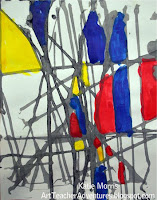 I've been thinking about clay lately. So far, I don't have access to a kiln. Other Art teachers, who are just trying to help with a "can-do" attitude, have offered the advice of "Get the high school Art teachers to fire it for you!" Well, when I have 750ish students, and they have waiting lists for Art courses, you can bet that their kilns are too busy firing work for their students to consider firing my students' work. But, there is good news! I am hopefully going to be getting a kiln by next fall! The fire marshal has approved a spot in the boiler room and one of my principals is excited and working on getting funding lined up for me. I don't even care too much that there are a bunch of stairs to get into the boiler room. All I asked him was who to check with to see if a location would be approved and he jumped right on board and took over making all the phone calls. Now I'm supposed to pick out a kiln (I'm told I want a computerized Skutt kiln?) and give him a price range so he can work out the funding.
I've been thinking about clay lately. So far, I don't have access to a kiln. Other Art teachers, who are just trying to help with a "can-do" attitude, have offered the advice of "Get the high school Art teachers to fire it for you!" Well, when I have 750ish students, and they have waiting lists for Art courses, you can bet that their kilns are too busy firing work for their students to consider firing my students' work. But, there is good news! I am hopefully going to be getting a kiln by next fall! The fire marshal has approved a spot in the boiler room and one of my principals is excited and working on getting funding lined up for me. I don't even care too much that there are a bunch of stairs to get into the boiler room. All I asked him was who to check with to see if a location would be approved and he jumped right on board and took over making all the phone calls. Now I'm supposed to pick out a kiln (I'm told I want a computerized Skutt kiln?) and give him a price range so he can work out the funding. *If you are curious about any of the projects pictured here, view my post from last spring: http://artteacheradventures.blogspot.com/2011/08/finished-clay-projects.html
In the mean time, I'm still working without a kiln. So here are a few tips I've come up with in my long, 2 1/2 year career.
- No talking with clay in your hands. The best way to do clay projects with my school schedule is one class period for wet clay and one class period to paint. To help students focus and finish on time, my rule is that there’s no talking while working with clay. The students are so excited that they really don’t mind working silently. (Most of the time.) I try to play music or read a book like “The Pot that Juan Built” by Nancy Andrews-Goebel while they work.
- Buy Air-Dry clay- If you can afford it. Some people say that there is no difference between air-dry clay and regular earthenware clay but I disagree. I order air-dry clay and when dry, it is harder and sturdier than the earthenware clay leftover from the previous teacher in my position.
- Cover basic skills but plan sturdy projects. Avoid attaching long, skinny pieces without support. It’s ok for the projects to be a little thick. Thick = Sturdier.
- Paint dry pieces. Obviously glaze is not an option with no kiln, but painting works well. I’ve used tempera and even watercolor. Just remind students not to use too much water or they will start to rehydrate the clay.
- The most important tip: Emphasize the process over the product. I know that being unable to fire clay projects leaves them in a fragile state and probably more than one project will be dropped in the hallway on the way home and shatter beyond repair. Because of this, I really emphasize to my students that the most important part of the lesson is learning the skills and getting practice. When pieces break, the students are sad, but I can remind them that we’ll work with clay again next year and they still learned a lot.

Do you have any no-kiln-available clay tips? If so, please share in the comments!

















































